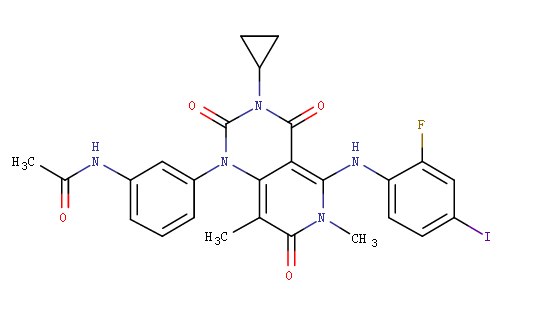Trametinib
Other name
-
International/Other brands
Mekinist
Groups
Approved
Structure

Prescription products
| Name | Dosage | Strength | Route | Labeller |
|---|---|---|---|---|
| Mekinist | Tablet | 1 mg | Oral | Novartis |
| Mekinist | Tablet, film coated | 0.5 mg | Oral | Novartis Europharm Limited |
| Mekinist | Tablet, film coated | 2 mg | Oral | Novartis Europharm Limited |
| Mekinist | Tablet | 2 mg | Oral | Novartis |
| Mekinist | Tablet, film coated | 1 mg/1 | Oral | Glaxosmithkline Inc |
| Mekinist | Tablet, film coated | 2 mg/1 | Oral | Novartis |
| Mekinist | Tablet | 0.5 mg | Oral | Novartis |
| Mekinist | Tablet, film coated | .5 mg/1 | Oral | Glaxosmithkline Inc |
Target
Description
Trametinib dimethyl sulfoxide is a kinase inhibitor. Each 1-mg tablet contains 1.127 mg trametinib dimethyl sulfoxide equivalent to 1 mg of trametinib non-solvated parent. FDA approved on May 29, 2013.
Indications
Indications
Other indications
Metastatic Melanoma; Unresectable Melanoma
Mechaism of action
-
Absorption
Trametinib is rapidly absorbed. When an oral administration of trametinib was given to patients with BRAF V600 mutation-positive melanoma, peak plasma concentration occurred 1.5 hours post-dose (Tmax). A single 2 mg oral dose has a bioavailability of 72%. When a dose of 2mg/day is given, the peak plasma concentration (Cmax) is 22.2 ng/mL.
Metabolism
Trametinib is metabolized predominantly via deacetylation alone or with mono-oxygenation or in combination with glucuronidation biotransformation pathways in vitro. Deacetylation is likely mediated by hydrolytic enzymes, such as carboxyl-esterases or amidases. The cytochrome P450 enzyme system is not involved with the metabolism of trametinib. The predominant circulating component in the plasma is the parent compound.
Toxicity
Most common adverse reactions (≥20%) for trametinib include rash, diarrhea, and lymphedema.